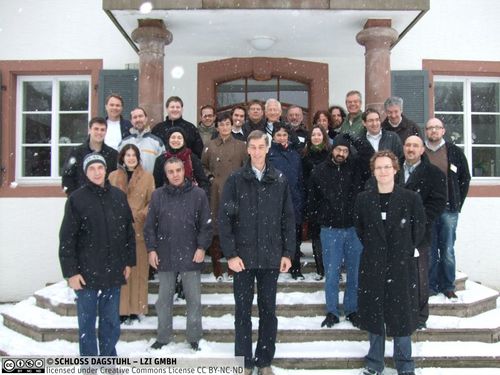Dagstuhl Seminar 10021
Service-Oriented Architecture and (Multi-)Agent Systems Technology
( Jan 10 – Jan 15, 2010 )
Permalink
Organizers
- Monique Calisti (Whitestein Technologies AG - Zürich, CH)
- Frank Dignum (Utrecht University, NL)
- Ryszard Kowalczyk (Swinburne University of Technology - Melbourne, AU)
- Frank Leymann (Universität Stuttgart, DE)
- Rainer Unland (Universität Duisburg-Essen, DE)
Contact
Today’s world not only has become more complex but also much more dynamic. From the business point of view this requires an IT that is not only affordable but also highly flexible and adaptable. In order to achieve this, the idea of software services composition (also called choreography or orchestration) came up. Here, enterprise applications are assembled from comparatively simple pre-existing building blocks that are loosely integrated in an efficient and meaningful way - especially tailored to the specific needs of the underlying business process. This leads to highly distributed and fluid software systems that may even cut across the boundaries of enterprises.
Software services are typically designed, built and deployed independently from each other, however, are meant to follow common standards to enable dynamic interoperability and loose coupling. If we take a look at what SOA is expecting to deliver we find, among others, features like flexibility, adaptability, autonomy, cooperation, or interoperability. However, if we take a look at current implementations of SOA it becomes clear that especially the mentioned features are far away from being realized yet. Implementations are usually static, provide comparatively little fault-tolerance and lack dynamism, versatility, and adaptivity. Moreover, it takes substantial human efforts to build such systems. This is where agent technology comes into the picture.
An agent is an autonomous and encapsulated software system that is situated in a particular environment. Among the properties that are associated with agents and multi-agent systems and which are also relevant for our seminar are autonomicity, adaptivity, reactivity, pro-activeness, mobility, goal-orientedness, cooperation, and interactivity, as can be implied from the above service-oriented architecture and multi-agent systems technology share a number of features on an abstract level.
However, if we take a look at the research areas of each community, their main focus seems to be different. Right now, the SOA community concentrates quite a lot on software services engineering. Service engineering methodologies with appropriate new service engineering methods, techniques and tools are developed. Active topics in the multi-agent systems community are collaboration, self-organization, adaptability, pro-activeness, and interoperability. However, in order to get the best out of it we need to combine these research efforts. If we consider IT to be the skeleton of an enterprise then SOA can be seen as the bones and agent technology as the cartilage that makes sure that the joints are properly connected, even if the mere bones may look completely incompatible when we just look at them.
Thus, agent technology may not help to realize the core functionality of a service but it may help substantially to wrap its functionality in a way that it becomes highly adaptable, more intelligent, more cooperative, and self-organizing. Replaceability, compatibility, and process conformance checks are tasks that can be performed well by agents on a higher level than just checking the interfaces of service descriptions. However, despite of all these potentials the research communities do not overlap much. As a consequence, possible synergies are not exploited and solutions are developed in each community that may not harmonize; i.e., the communities do not benefit much from each others work. One of the main goals of this seminar is to bridge the gap between these communities and to stipulate a fruitful and long-lasting collaboration.
- Stanislaw Ambroszkiewicz (Polish Academy of Sciences - Warsaw, PL)
- Ivona Brandic (TU Wien, AT) [dblp]
- Cherif Branki (University of the West of Scotland - Paisley, GB)
- Frances Brazier (TU Delft, NL) [dblp]
- Owen Cliffe (University of Bath, GB)
- Christian Derksen (Universität Duisburg-Essen, DE) [dblp]
- Frank Dignum (Utrecht University, NL) [dblp]
- Virginia Dignum (TU Delft, NL) [dblp]
- Antonio García Domínguez (University of Cádiz, ES)
- Benjamin Hirsch (TU Berlin, DE)
- Michael N. Huhns (University of South Carolina - Columbia, US) [dblp]
- Jana Köhler (IBM Research GmbH - Zürich, CH) [dblp]
- Ryszard Kowalczyk (Swinburne University of Technology - Melbourne, AU) [dblp]
- Winfried Lamersdorf (Universität Hamburg, DE) [dblp]
- Tim Lessner (University of the West of Scotland - Paisley, GB)
- Wathiq Mansoor (American University in Dubai, AE)
- Ganna Monakova (Universität Stuttgart, DE)
- Lars Mönch (FernUniversität in Hagen, DE) [dblp]
- Andreas Oberweis (KIT - Karlsruher Institut für Technologie, DE) [dblp]
- Guadalupe Ortiz Bellot (University of Cadiz, ES) [dblp]
- Julian Padget (University of Bath, GB) [dblp]
- Thomas Quillinan (Thales Netherlands - Delft, NL)
- Munindar P. Singh (North Carolina State University - Raleigh, US) [dblp]
- Sebastian Stein (University of Southampton, GB)
- Rainer Unland (Universität Duisburg-Essen, DE) [dblp]
- Alexander Walz (Universität Stuttgart, DE)
- Danny Weyns (KU Leuven, BE) [dblp]
Classification
- artificial intelligence / robotics
- sw-engineering
Keywords
- (Multi-)Agent Systems Technology
- Web Services
- Service Oriented Architectures
- Autonomic Computing
- Semantic Web
- Self Organizing Systems


